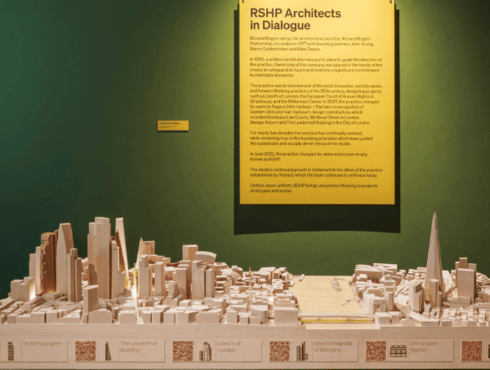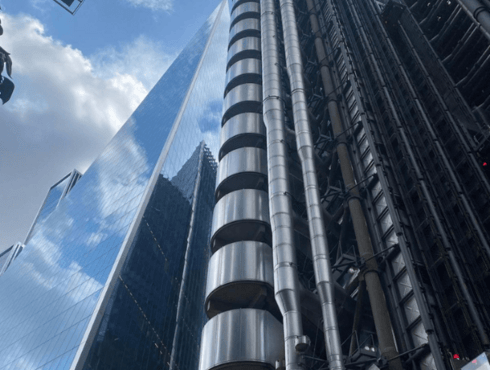Please note: This event is now sold out, with no tickets available on the door.
Join us for this exciting partnership event between Sir John Soane’s Museum and RSHP (formerly Rogers Stirk Harbour + Partners) in the iconic Leadenhall Building.
Taking place in the Leadenhall Building, famously known as the ‘Cheesegrater’ and where RSHP’s studio is now based, this exclusive event will explore the legacy of Richard Rogers, RSHP’s design philosophy and the future of architecture. Themes including architecture in the public realm, urban renaissance, legibility and joy in design will be explored by our expert panel. Chaired by Will Gompertz, Director of Sir John Soane’s Museum, panellists will include Alice Rawsthorn, design critic, Ivan Harbour, Senior Design Director at RSHP, Tracy Meller, Senior Director and Stephen Barrett, Director.
The talk will be followed by a Q&A with the panel and a drinks reception.
This event is part of the public programme complementing our exhibition Richard Rogers: Talking Buildings which runs from Wednesday 18 June – Sunday 21 September 2025.
About the event
Venue:
RSHP Studio, Level 14, The Leadenhall Building, 122 Leadenhall Street, London EC3V 4AB
Timings for the evening will be as follows:
18:00 Doors open
18:30 Event begins
19:15 Q&A
19:00 Drinks reception
20:00 Event ends
Please bring photographic ID to gain access to the building. There will be a soft bag check as required by the Leadenhall Building management team.
About the panellists
Will Gompertz joined the Soane in 2024 from the Barbican, where – as Artistic Director - he helped reopen the Centre after the pandemic. Prior to the Barbican, he was the BBC’s Arts Editor for eleven years. He has interviewed countless architects, artists, actors, writers, musicians and directors, as well as writing and presenting documentaries for BBC television and radio. Will spent seven years as a director of the Tate Galleries and has written three internationally celebrated books: What Are You Looking At? (2012), Think Like an Artist (2015) and See What You’re Missing (2023). He has lectured on the arts and creativity nationally and internationally, including giving talks at the Museum of Modern Art, V&A, National Gallery, Picasso Museum, Louvre Museum, Royal Academy, and Oxford and Cambridge Universities.
Alice Rawsthorn is an award-winning design critic and the author of critically acclaimed books on design, including Hello World: Where Design Meets Life, Design as an Attitude and, most recently, Design Emergency: Building a Better Future. She is a co-founder with Paola Antonelli of the Design Emergency project to investigate design's role as a force for positive change. In all her work, Alice champions design's potential to address complex social, political and ecological challenges. She was an award-winning journalist for the Financial Times for nearly twenty years, working as a foreign correspondent in Paris and pioneering the FT's coverage of the creative industries. For over a decade, Alice was design critic of the international edition of The New York Times, writing a weekly Design column, which was syndicated to other media worldwide.
Ivan Harbour is an architect and senior director at RSHP. He began his career on Lloyd’s of London and subsequently led the design of the European Court of Human Rights and Bordeaux Law Courts. He was a director in the practice from 1993, and he is a founding partner of Rogers Stirk Harbour + Partners, established in 2007. In 2022, the practice rebranded as RSHP. Two of Ivan’s projects – Terminal 4 Barajas Airport Madrid (2006) and Maggie’s West London (2009) – have won the Stirling Prize, the most prestigious architectural award in the UK. He remains deeply involved in design from city scale to the smallest detail and, together with Graham Stirk, promotes and develops the ethos and design quality the practice is renowned for. Ivan is currently leading the design on the Melbourne Metro Rail project. Other live projects include Taoyuan T3 airport, Taiwan; and the Hammersmith Town Hall redevelopment in London. He also plays an instrumental role in developing modular housing pioneered at Y:Cube, London, UK.
Tracy Meller has been involved in a wide range of projects at all stages, across the residential, commercial, healthcare, and education sectors for over 20 years. As lead architect on projects such as LSE Centre Building (London School of Economics), NEO Bankside and Mossbourne Community Academy, Tracy has a track record of delivering innovative schemes on some of the most complex urban sites. From the initial competition in 2013 through to completion in 2019, Tracy was the partner responsible for the design development and delivery of Centre Building at the LSE. By building a strong and mutually respectful relationship with the LSE estates team and wider consultant group, Tracy was able to lead the team through the evolution of the brief, stakeholder consultation, design development and contractor selection process. In 2020, Tracy was awarded the Inaugural MJ Long Award for Excellence in Practice 2020 for her work on Centre Building at the LSE. The MJ Long Prize is open to all UK-based female architects and is judged on an overall body of work, with an emphasis on a project completed in the past 18 months. Also in 2020, Tracy was made Honorary Professor of Architecture at the University of Nottingham.
Stephen Barrett has over 30 years of experience with the practice and leads the French and French-speaking teams and projects within RSHP. He was project architect for the Bordeaux Law Courts, Terminal 4 Barajas airport, Madrid, the Control Tower at Heathrow Airport and, more recently, the new west wing at Geneva Airport. Also fluent in Spanish, Stephen spent two years seconded to the RSHP Madrid office as project architect for Campus Palmas Altas in Seville. In addition to more than a dozen airport projects, Stephen has managed the multidisciplinary teams of urban and strategic projects for Grand Paris (2008-2012), Bercy Charenton (2009-19), Gare de Lyon-Daumesnil, (2014 -), Roads of the Future Grand Paris and, latterly, the Montparnasse Masterplan. He leads RSHP’s Sustainable Development group and recently managed the audit of the practice’s carbon footprint.
Image: Lloyd’s of London on the left and The Leadenhall Building on the right. Copyright: ©Paul Raftery


